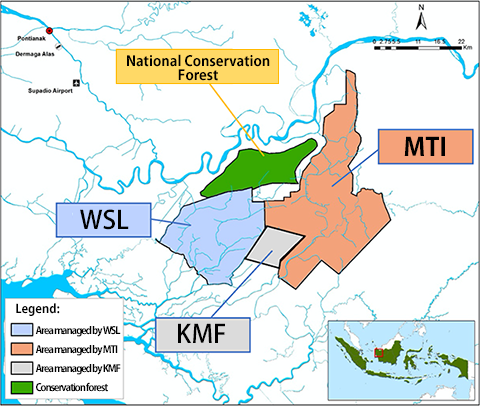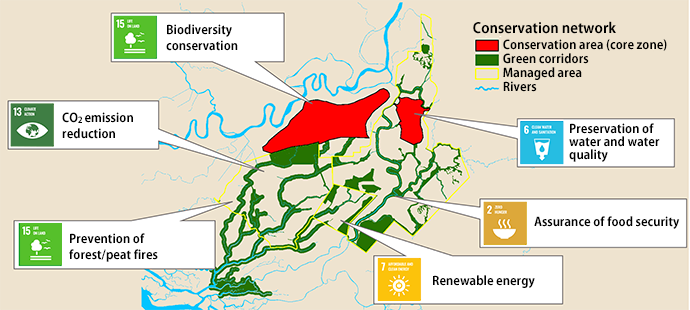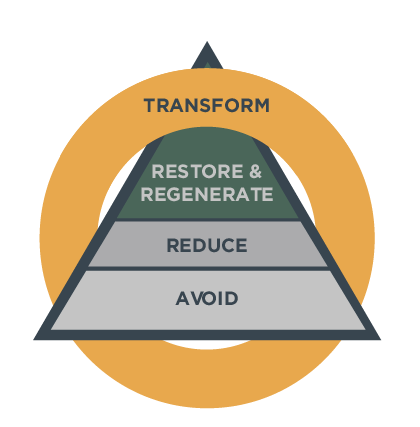- Home
- Sustainability Report
- Environment
- Biodiversity Conservation
- Policies for Biodiversity Conservation
Policies for Biodiversity Conservation
Declaration of Biodiversity and Biodiversity Action Guidelines
Sumitomo Forestry established its policy on Biodiversity Conservation in Company-owned Forests in Japan in fiscal 2006, and its Wood Procurement Philosophy and Policy in fiscal 2007. The Company also revised its Environmental Policies in fiscal 2007 to incorporate biodiversity considerations. Then in March 2012, the Sumitomo Forestry Group established its Declaration of Biodiversity, setting out the Sumitomo Forestry Group's understanding of and stance on biodiversity; Biodiversity Action Guidelines, specifying an internal set of guidelines; and Biodiversity Long-Term Targets as specific goals of activity.
In July 2015, the Group initiated the Sumitomo Forestry Group Environmental Policy, bringing together the Environmental Philosophy*, the Environmental Policies, the Sumitomo Forestry Group Declaration of Biodiversity, and the Sumitomo Forestry Group's Biodiversity Action Guidelines. Therefore, the efforts in biodiversity are also operated based on the policies integrated in the Sumitomo Forestry Group Environmental Policy.
* The Sumitomo Forestry Group formulated the Environmental Philosophy in 1994 and the Environmental Policies in 2000
- Click here for related information
Company Structure for Biodiversity Conservation
In accordance with our environmental management structure, the Representative Director and President is the person in charge of the Sumitomo Forestry Group's biodiversity conservation initiatives, and the Executive Officer in charge of the Sustainability and the General Manager of the Sustainability Department manage the Sumitomo Forestry Group company activities.
Commitment to Protected Areas
To manufacture and secure wood resources, the Sumitomo Forestry Group owns or manages many forests both in Japan and overseas. None of these forests is located in areas designated as world heritage sites.
Furthermore, we have not and will not operate in areas designated as world natural heritage sites. Regardless of land ownership, national parks in Japan, which has a small land area, operate under the Regional Natural Park System and many national parks include private property. A portion of Sumitomo Forestry's Company-owned forests are located inside national park areas, and as is the case for other areas designated as protected forests etc., we operate in strict compliance with all legal regulations.
Furthermore, in terms of risk assessment, in areas determined to be important from a biodiversity perspective, we not only strictly adhere to all legal regulations, but also work to mitigate our impact through reevaluation, minimization, revitalization, offsetting and other efforts.
We manage approximately 48,000 hectares of Company-owned forests in Japan and approximately 240,000 hectares of forests overseas. These managed forests are categorized as "Conservation Forests" and "Working Forests" etc. In both Japan and overseas, "Conservation Forests" are, in principle, natural protection areas where no operations are carried out.
Zoning Management According to Forest Purpose
The borders of these lands set by the government do not always match the boundaries of the ecosystem. The Indonesian subsidiaries PT. Wana Subur Lestari (WSL), PT. Mayangkara Tanaman Industri (MTI), and Kubu Mulia Forestry (KMF) conducted thorough animal and plant surveys that included conservation forest neighboring areas under governmental management before defining preservation areas and business areas. WSL and MTI also worked with local organizations to build a conservation network that defines a net of green corridors to prevent closed off islands which would isolate the regions where orangutans, long-nose monkeys and other rare flora and fauna live.
Forest Management Area in Indonesia

Conservation Network

Evaluation of Initiatives by Stakeholders
The concept and specific initiatives of the Conservation Network proposed by WSL and MTI are attracting attention at home and abroad as a rare global initiative. At the 25th session of the Conference of the Parties to the United Nations Framework Convention on Climate Change (COP25) in Madrid, Spain in 2019, we presented as a representative of the private sector at the Indonesia Pavilion and were highly appreciated by international organization representatives, researchers, and NGOs. We also presented our technical approach to the challenges surrounding tropical forests and our initiatives at COP27, held in Sharm El Sheikh, Egypt, in 2022, and COP28, held in Dubai, United Arab Emirates, in 2023.
In addition, in our urban landscaping business, we are striving to improve the quality of our greening efforts through third-party certification by actively encouraging our customers to register for "Ikimono Kyosei Jigyousho" certification set by the Association for Business Innovation in Harmony with Nature and Community (ABINC) or the Social and Environmental Green Evaluation System (SEGES) green certification implemented by the Organization for Landscape and Urban Green Infrastructure.
Actions for Biodiversity Conservation
In order to achieve coexistence and symbiosis with nature, the Sumitomo Forestry Group has set numerical targets based on material issues in Sustainability section of Mid-Term Sustainability Targets and is managing progress toward achievement of Nature Positive, which aims to reduce natural losses to zero and turn nature on a recovery track, by 2030. The Sumitomo Forestry Group's initiatives, including these, are organized in accordance with the framework of actions to achieve nature positivity recommended by SBT for Nature, as follows.

Source: Science Based Targets Network, 2020. "Science-Based Targets for Nature: Initial Guidance for Business Executive Summary
| Basic Policy | Initiatives and Commitments | |
|---|---|---|
| Avoidance | The Sumitomo Forestry Group has formulated the Sumitomo Forestry Group Procurement Policy and Wood Procurement Management Regulations, and procures only sustainable timber and wood products that conform to these policies, avoiding the use of problematic timber and wood products. In our forestry business, we manage forests separately as "working forests" for wood production and "conservation forests" for environmental conservation, avoiding business in areas where biodiversity must be preserved. In company-owned forests in Japan, the company has also created the Riparian Forest Management Manual to ensure restricted operations in areas around bodies of water that are rich in biodiversity. | ・Annual Sustainability Procurement Survey in supply chain
・Wood Procurement Committees are held four times a year ・Certification acquisition rate of incoming PKS (100% in FY2024 target) ・Securing ratio of conservation forests in company-owned forests (more than 30% in FY2024 target) ・Prepared the Sumitomo Forestry Red Data Book and Riparian Forest Management Manual, and implemented appropriate management and conservation. ・Conduct mangrove conservation project in Indonesia ・Initiatives toward Net Zero Greenhouse Gas Emissions ・Conservation Activities for the National Natural Monument "Tsugazakura (Phyllodoce nipponica) Community of Mt. Dozan", a company-owned Forest in Niihama, Ehime Prefecture, and Registration as a Natural Symbiosis Site in the Ministry of the Environment |
| Reduction | By promoting the recycling of wood, we aim to reduce resource consumption and increase efficiency, thereby realizing a circular bioeconomy and reducing the burden on nature. In our forestry business, we advance sustainable forest management to ensure that wood resources will be available in perpetuity while preserving public benefits of forests, including biodiversity conservation. | ・Development of wood cycle (acceleration of cyclical forest management, promotion of wood change, each business based on standardization of carbon neutral design)
Examples: Establishment of forestry fund, NeXT FOREST (an AI model that contributes to CO2 emissions and forest fire control in tropical peatlands), establishment of timber industrial complex, wood change (replacement of steel, concrete, fossil fuels, etc. with wood), promotion of OneClickLCA and environmental labeling EPD (visualization of CO2 emissions during construction) ・Final disposal of industrial waste (reduction rate compared to FY2021: 5.4%; reduction planned for FY2024) ・Recycling rate at new housing construction sites (FY2021 result: 95.1% against FY2024 plan: 98.0%) ・Recycling rate of waste at manufacturing plants (FY2021 results: overseas 98.5%, domestic 99.1% against FY2024 plan: 99.0%/99.0%) ・Unused resources (biomass use) handling volume (planned for FY2024:19,202 m3) ・Domestic and overseas forest certified area (FY2021 actual 221,971 ha against FY2024 plan 242,493 ha) ・Maintaining 100% SGEC certified area (company-owned forests in Japan) |
| Restoration and reproduction | We are engaged in activities to restore and regenerate biodiversity that has been lost or threatened with loss, in our core business of urban and residential landscaping business and in social contribution activities that utilize management resources cultivated through our business activities. | ・Increase in the number of native tree species sold (465,000 in FY2021 against 500,000 planned for FY2024), and promotion of "Harmonic Plants®" that sets guidelines for the selection of tree species, mainly native species, according to the target sites for afforestation
・Promote acquisition of ABINC certification for urban landscaping business, etc. ・Mt. Fuji Manabi no Mori project to restore 30ha of typhoon- damaged national forest at the foot of Mt. Fuji ・Carried out the Oku-Matsushima Nature Restoration Volunteer Program, a tree-planting activity to restore the tsunami-devastated coastal area at the time of the Great East Japan Earthquake |
| Reform | We participate in and communicate our opinions on the activities of domestic and international rulemaking, industry associations, and related organizations regarding nature and biodiversity, and support the activities of NGOs and other organizations. | ・Participated in TNFD Forum
・Joined the WBCSD Forest Solutions Group and got involved in the process of developing the Nature Positive Roadmap (to be released in 2022) and the TNFD Forest Sector Guidelines (to be released in 2023). ・Signing of the commitment of Business for Nature's "Call to Action" and "COP15 Business Statement for Mandatory Assessment and Disclosure ・Participation as a pilot company in the development of new guidelines for GHG protocols to calculate GHG removals and emissions from biological and soil-based sources ・Participation in the 30 by30 Alliance led by the Ministry of the Environment ・Served as vice-chairperson of the Keidanren Nature Conservation Council and joined the Japan Business Initiative for Biodiversity (JBIB) |
- Home
- Sustainability Report
- Environment
- Biodiversity Conservation
- Policies for Biodiversity Conservation

